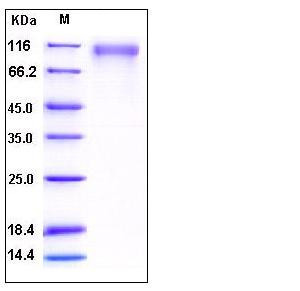Human SLITRK1 Protein (His Tag)
FLJ54428,KIAA0918,KIAA1910,LRRC12,RP11-395N17.1,SLITRK1,TTM
- 100ug (NPP4275) Please inquiry
| Catalog Number | P10340-H08H |
|---|---|
| Organism Species | Human |
| Host | Human Cells |
| Synonyms | FLJ54428,KIAA0918,KIAA1910,LRRC12,RP11-395N17.1,SLITRK1,TTM |
| Molecular Weight | The recombinant human SLITRK1 consists of 610 amino acids and predicts a molecular mass of kDa. As a result of glycosylation, the apparent molecular mass of rhSLITRK1 is approximately 105-115 kDa in SDS-PAGE under reducing conditions. |
| predicted N | Asn 18 |
| SDS-PAGE |  |
| Purity | > 95 % as determined by SDS-PAGE |
| Protein Construction | A DNA sequence encoding the extracellular domain (Met 1-Ser 616) of human SLITRK1 (NP_443142.1) was expressed with a C-terminal polyhistidine tag. |
| Bio-activity | |
| Research Area | Neuroscience |Neurology process |Growth and Development |Axon Guidance |SLITRK |
| Formulation | Lyophilized from sterile PBS, pH 7.4 1. Normally 5 % - 8 % trehalose, mannitol and 0.01% Tween80 are added as protectants before lyophilization. Specific concentrations are included in the hardcopy of COA. |
| Background | SLITRK1 (Slit and Trk-like family member 1) is a integral membrane protein belonging to the SLITRK family consists of at least 6 members (SLITRK1-6). They are named and characterized by the presence of two leucine-rich repeats (LRRs) in the extracellular domain similar to those found in a secreted axonal growth-controlling protein, Slit, as well as a C-terminal domain with homology to Trk neurotrophin tyrosine kinase receptors. Expression of SLITRKs are highly restricted to neural tissues, and are identified as the neuronal components modulating the neurite outgrowth. More specifically, SLITRK1 expression is found in the mature neurons of the cerebrum, thalamus and hippocampus, and induces unipolar neurites in cultured neuronal cells. Human SLITRK1 is a 696 amino acid precursor protein, and one truncating frameshift mutation (448 aa) has been linked to Tourette's syndrome, a genetically influenced developmental neuropsychiatric disorder characterized by chronic vocal and motor tics. In addition, all SLITRK genes are differentially expressed in brain tumors, such as astrocytoma, oligodendroglioma, glioblastoma, and are suggested to be useful molecular indicators of brain tumor properties. |
| Reference | 1. Aruga, J. and Mikoshiba, K. 2003, Mol. Cell. Neurosci. 24: 117-129. 2. Aruga, J. et al., 2003, Gene. 315: 87-94. 3. Abelson, J.F. et al., 2005, Science. 310: 317-320. 4. Grados, M.A. and Walkup. J.T. 2006, Trends. Genet. 22: 291-293. |
